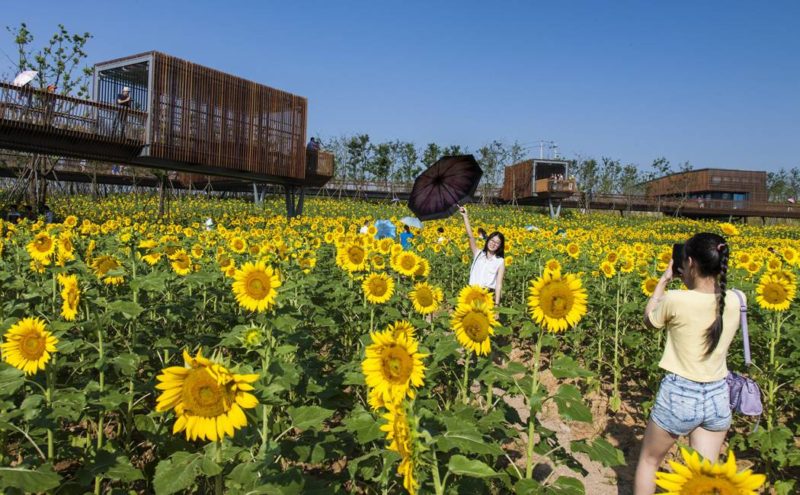Article by Irene Crowo Nielsen – We take a deeper look at planting plans and discuss 10 mistakes you really don’t want to mane when creating a planting plan. For a landscape architect, the planting plan is like the cherry on top of the ice cream sundae: It makes the design and concept come together. A good planting plan creates a framework allowing people to interact and thrive in different environments. But creating a good planting plan can be tricky. There are a few things you should be aware of before setting out on this task. We are going to help you along the way by listing a few bullet points you definitely should avoid:
Get Your Planting Plan Done Right
1. Choosing Poisonous Plants
It is easy to be deceived by plants; one part may be edible while another is poisonous. Others can hurt if you get them on your skin. Whatever you do, avoid planting poisonous plants in public spaces or in private gardens where children will be present. Foxglove is an example of a common flower that is highly poisonous. A good alternative for Foxglove is Hollyhock. Other poisonous plants include Water Hemlock, buttercups, Lily-of-the-Valley, Hyacinth, Oleander, and Iris. Check charts, books, or other sources for poisonous plants that apply to your country before making a planting plan. Treat unknown plants with respect, and teach your children to do the same. 2. Selecting Dangerous Trees It’s scary how dangerous trees can be, so be careful with the type of trees you are choosing for you planting plan. Take the Silver Maple and the Bradford Pear, for example. Both are prone to lightning strikes and to splitting. 3. Using Scattered Colors Less is more! Color is a powerful design tool. Too much sense of color without harmony can become a distraction. Choose your key plant and add color combinations that blend well with it. For example, you will want to select either harmonious or contrasting colors. Harmonious colors are found next to each other on the color wheel and share similar values (i.e. violet and blue or yellow and orange).

What do you think of this color selection? Photography Credits Go To Eran Karu
- Spring: Tulip, Crocus, Snowdrop, Daffodil, Peony, Pansy, or Forsythia
- Summer: Daylily, Coneflower, Zinnia, Nasturtium, Rose, or Hydrangea
- Fall: Asters, Ornamental grasses, Mums, Hardy begonias, Ornamental kale, or Sedum
- Winter: Evergreen Hollies, firethorn, or chokeberry bushes

Quzhou Luming Park. Photos courtesy of Turenscape.
5. Ignoring the Sun
Have you remembered to plant for the sun? Do you know how many hours of full sunlight the outdoor area will get each day? Ignoring the importance of a sun/shadow analysis can cost you a beautiful planting plan in regard to its lusciousness and will to survive. Color through the season is also easier to achieve in a sunny garden. Most shade-tolerant perennials bloom early in the season, so a shade garden will not be as colorful as a sunny flower garden.
6. Over-planting or Under-planting
Be sure to give the plants enough space, but remember that too much space between plants will make the design look less luscious and more like a desert. The ideal space when arranging individual plants in the beds is to space them so that they will touch when they reach mature size. Another tip is to think about vertical and horizontal layers with a repeating pattern of plants. By repeating colors, forms, spacing, or textures of plants throughout your planting plan, you will create a recognizable pattern in the landscape. 7. Choosing Non-site-specific Plants Not checking what type of trees, shrubs, and plants will do well on your site and in the soil you have can cause you a massive headache. Have you decided to use a plant that is suitable for sandy soils, but really you’re on clay soil? Look for information in charts or books to make sure you are planning for the best possible plants for your soil conditions. 8. Ignoring Soil Depth Another important point (which cannot be said enough) is to double-check and agree on all soil depths with the client ahead of time, then decide what plant, tree, or shrub goes where. This is especially important when you are planting on top of a parking complex or some place similar. Clear it up with the client (fight for depth!) before you start making your planting plan. This will make your job so much easier, and the trees, plants, or shrubs you choose will live happily ever after.

Roofpark Vierhavenstrip. Photo credit: Stijn Brakkee
9. Planting a Tree Too Close to a Structure
This is a common mistake by new designers — they plant ornamental trees too close to a house or building and the plants end up growing into the structure and blocking the light.

Buddha Head in Tree. By Tommy Tang – Own work, CC BY-SA 3.0,
Recommended Reading:
- Becoming an Urban Planner: A Guide to Careers in Planning and Urban Design by Michael Bayer
- Sustainable Urbanism: Urban Design With Nature by Douglas Farrs
- eBooks by Landscape Architects Network
Article by Irene Crowo Nielsen
Published in Blog







